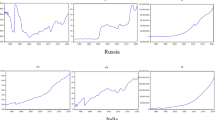Abstract
A number of researchers have found that the rate of exchange rate pass-through (ERPT) to domestic prices has declined substantially over the last few decades. We revisit this claim of a shrinking exchange rate effect on the Consumer Price Index (CPI) in a vector autoregressive (VAR) model for US macroeconomic data under the current floating exchange rate regime. Our VAR approach nests the conventional single equation method and reveals statistically significant evidence of ERPT to the CPI only during later observations, sharply contrasting with previous findings. After confirming structural breaks in ERPT via statistical tests by Hansen (Journal of Economic Perspectives, 15(4), 117–128, 2001) and Qu and Perron (Econometrica, 75(2), 459–502, 2007), we seek the source with disaggregated level CPIs, and pin down a key role of energy prices. US energy imports increased from the 1990s until the recent recession. This market changes magnify the effects of the exchange rate shocks on domestic energy prices, resulting in greater responses of the total CPI via the energy price channel.






Similar content being viewed by others
Notes
We demean the VAR prior to estimations.
The information set Ωt is adaptive in the sense that \({\Omega }_{j}\supseteq {\Omega }_{j-1},\forall j\).
The IRF estimates \(E\left ({\Delta } y_{t+j}|u_{\Delta s,t}=1,{\Omega }_{t-1}\right ) -E\left ({\Delta } y_{t+j}|{\Omega }_{t-1}\right ) \) are also numerically identical even if Δyt and Δpt switch their location.
Additional control variables can be added in the right hand side of the equation, which can be also easily nested by VAR models following the procedure in the present paper.
When the ordering is \(\left [ {\Delta } s_{t}~{\Delta } p_{t}~{\Delta } y_{t}\right ]^{\prime }\), (7) remains the same but βy,0 = 0 by construction.
We also implemented the same analysis with a 30-year window scheme. Results are qualitatively similar and are available upon requests.
Alternatively, the Wald or the Likelihood Ratio statistics can be used.
These results are available upon request.
We obtain the long-run rate of ERPT from the IRF approach by taking the value of η(20). j = 20 (quarter) seems to be sufficient for the IRF to become stabilized.
We obtained the data from the U.S. Energy Information Administration website.
Detailed results are available upon requests.
References
Andrews DWK (1993) Tests for parameter instability and structural change with unknown change point. Econometrica 61(4):821–856
Andrews DWK, Ploberger W (1994) Optimal tests when a nuisance parameter is present only under the alternative. Econometrica 62(6):1383–1414
Campa JM, Goldberg LS (2005) Exchange rate pass-through into import prices. The Review of Economics and Statistics 87(4):679–690
Christiano LJ, Eichenbaum M, Evans CL (1999) Monetary policy shocks: What have we learned and to what end?. Handbook of Macroeconomics 1:65–148
Frankel J, Parsley D, Wei S-J (2012) Slow pass-through around the world: A new import for developing countries?. Open Economies Review 23 (2):213–251
Gagnon JE, Ihrig J (2004) Monetary policy and exchange rate pass-through. International Journal of Finance & Economics 9(4):315–338
Hansen BE (1997) Approximate asymptotic P values for structural-change tests. Journal of Business & Economic Statistics 15(1):60–67
Hansen BE (2001) The new econometrics of structural change: Dating breaks in U.S. labour productivity. Journal of Economic Perspectives 15(4):117–128
McCarthy J (2007) Pass-through of exchange rates and import prices to domestic inflation in some industrialized economies. Eastern Economic Journal 33(4):511–537
Qu Z, Perron P (2007) Estimating and testing structural changes in multivariate regressions. Econometrica 75(2):459–502
Takhtamanova YF (2010) Understanding changes in exchange rate pass-through. Journal of Macroeconomics 32(4):1118–1130
Taylor JB (2000) Low inflation, pass-through, and the pricing power of firms. European Economic Review 44(7):1389–1408
Author information
Authors and Affiliations
Corresponding author
Additional information
Publisher’s Note
Springer Nature remains neutral with regard to jurisdictional claims in published maps and institutional affiliations.
Appendix
Appendix
Rights and permissions
About this article
Cite this article
Kim, H., Lin, Y. & Thompson, H. Exchange Rate Pass-Through to Consumer Prices: The Increasing Role of Energy Prices. Open Econ Rev 32, 395–415 (2021). https://doi.org/10.1007/s11079-020-09601-7
Published:
Issue Date:
DOI: https://doi.org/10.1007/s11079-020-09601-7




